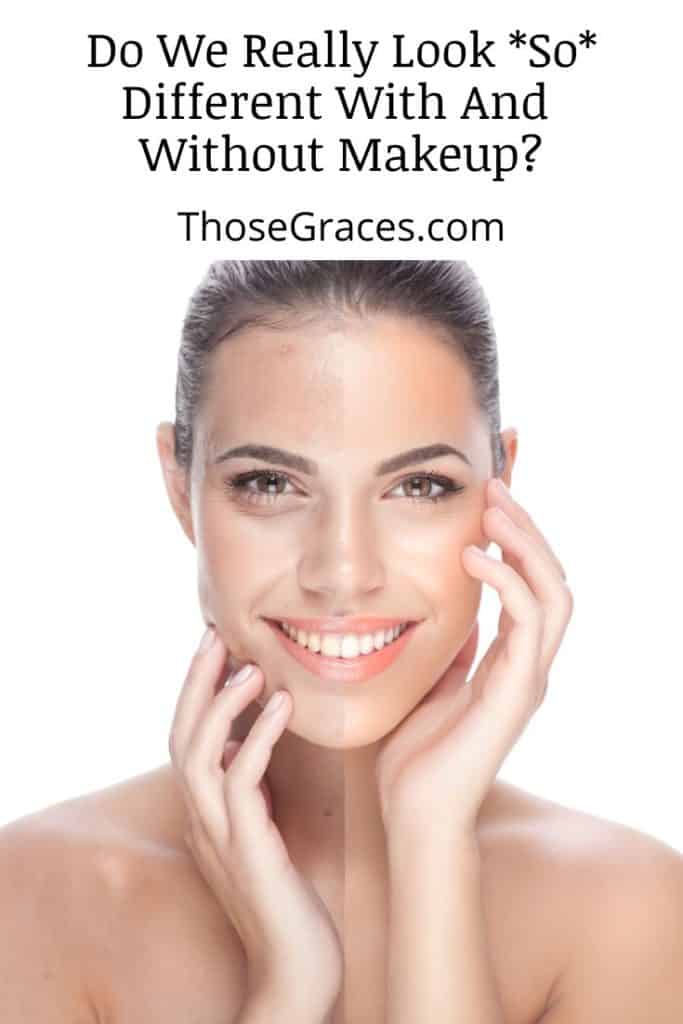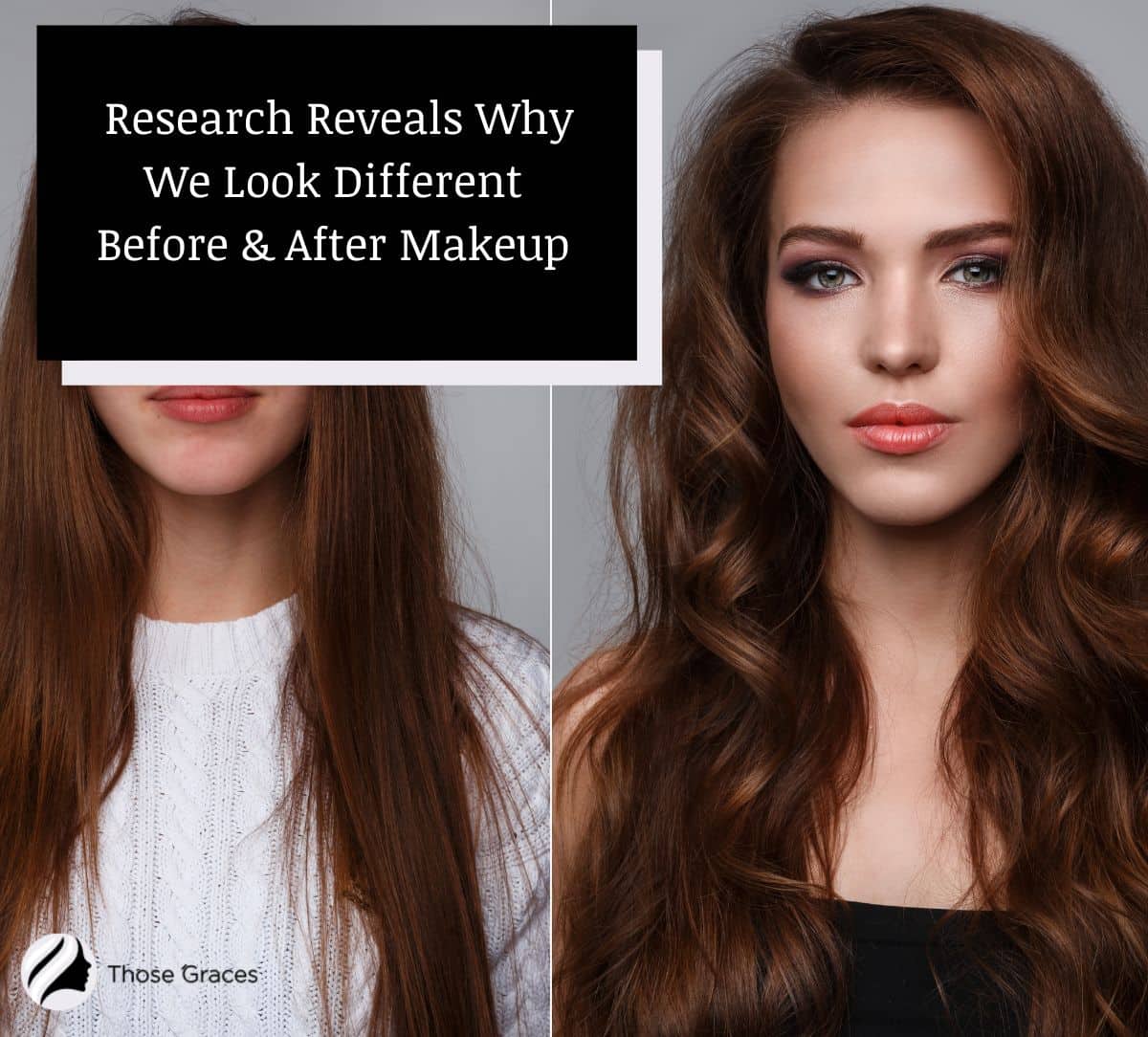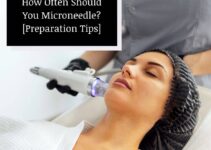Have you ever looked at before and after makeup pictures of celebrities and wondered what makes us look so different with and without a made-up face?
This post dives deep into the relevant academic research to find out!
Keep reading to find the answers to the following questions and more!
- Is beauty purely subjective?
- Does wearing beautiful makeup me us look more attractive to other people?
- Does applying makeup products (light vs. heavy) make a difference in how others perceive us?
Table of Contents
Key Takeaways:
- There are different standards of beauty in different parts of the world; however, studies show there’s a ratio of facial proportions that is universally considered attractive.
- Studies also show that women are rated as more attractive after applying makeup in photographs and real-world situations.
- Makeup can influence others’ perceptions of you as well as your self-confidence.
- Regardless of what research shows, there is no need to feel pressure to use or not use cosmetics. You do you!

Credit: @Trangformation
Looks Aren’t Everything
The purpose of this article is to introduce academic research on beauty and cosmetics. Remember – there’s more to life than your appearance. Beauty is partly subjective.
We believe your clean skin and bare face are just as beautiful as your made-up face! Never feel pressured to wear (or not wear) any beauty products.
Do We Really Look *So* Different With And Without Makeup?
Yes, makeup can significantly impact the way you look.
Excessive makeup can alter the appearance of the face so drastically that it can impair the accuracy of automatic facial recognition systems. (1, 2)

f you’re curious about “does makeup age you” or looking for an everyday makeup look, be sure to check out our articles for tips and insights.”
Isn’t Beauty Purely Subjective?
What is considered beautiful is a mix of subjective and objective influences.
It’s true that there are cultural and individual-level differences in what is considered beautiful around the world. Physical beauty is, in part, in the eyes of the beholder.
However, humans are also innately attracted to each other to increase the chances of producing healthy children capable of surviving into adulthood. (3)
Some physical characteristics are near universal indicators of beauty because they signal health and fertility – important traits for producing healthy offspring.
These are the more objective elements of beauty. With this in mind, we know makeup alters our appearance to accentuate certain features that signal fertility.
There’s some evidence that women are especially likely to use cosmetic products to enhance their beauty at the most fertile stage in their menstrual cycle:
- In a study conducted by Guéguen, women reportedly spent more time applying beauty products near the ovulation phase of their cycle. (4)
- This supported previous research that found that women alter their appearance when ovulating to boost their attractiveness. (5)
- In the Guéguen study, makeup artists claimed that women’s makeup application was better and more advanced near ovulation. (4)
Guyliner and Manscara
In many civilizations throughout history, including ancient Egypt, men also wore makeup – not just women. (6)
Men look ‘normal‘ to us without beauty products. When we see adult women who usually wear makeup without it, they often look noticeably different.
As a society, we’re more accustomed to seeing women wearing cosmetics than men.
More men are beginning to wear cosmetics throughout the western world as it becomes more socially acceptable.
However, it’s still largely the social norm in our society for only women to wear makeup.
If you’re concerned about the effects of makeup on your skin, you might want to check out our article on “does makeup cause wrinkles” for some helpful insights and tips.
So, Why Is That?
Buss, an evolutionary psychologist, explains that the evolutionary pressures for men and women are not the same. (7)
While women have evolutionary pressures to highlight youthfulness and health to signal fertility, men have pressures to signal high levels of wealth to attract a mate.
From a purely evolutionary perspective, it doesn’t make sense for men to spend time and money on beauty if it doesn’t aid them in the purpose of attracting healthy women.

How Is Beauty Objective?
There are objective standards of attractiveness that are common among humans. Let’s discuss two examples.
Maybe you’ve heard of the ‘golden ratio’ before?
It’s a special number (1.618) that frequently occurs throughout nature, and 1.618 is often heralded as the ‘ideal’ distance ratio between facial features for optimum attractiveness. (8)
A study by Pamela Pallett et al. at the University of California San Diego did not support the ‘1.618′ ratio as the facial ideal. (9)
However, the authors did find support for a different facial golden ratio – a ratio that aligned closely with an ‘average’ face.
In similar studies, generating a digital face average from multiple images of varying faces resulted in a more attractive face than any of the individual composite pictures. (10, 11)
This suggests average faces are more attractive. In this case, an ‘average’ face does not refer to a face rated average on the attractiveness scale.
Rather, an average face is a face close to the mathematical average of a large number of people’s features.
Take another example: smooth skin and even skin tone are other indicators of good health and are considered objectively attractive. (12, 13)
Now that we’ve learned about some of the more objective elements of beauty let’s discuss how cosmetics can accentuate these beauty signals.
Does Makeup Help You Look More Attractive?
Certain cosmetic products, when applied correctly, can help you look younger and exaggerate health and fertility cues. (14)
For example:
- Foundation can help correct an uneven skin tone and texture.
- Basic eye makeup can enhance youthfulness and accentuate facial neoteny, which is characterized by youthful features like big eyes, a small nose, and large lips. (15)
- Dr. DiDonato suggests that applying blush could help to mimic the higher likelihood of blushing when ovulating – a subtle signal of fertility. (16)
The Photograph Studies
Using certain cosmetics can, in theory, enhance signals of beauty. But, what happens in reality?

Academics have conducted experiments to determine if cosmetics really have an impact on a woman’s perceived attractiveness.
These studies typically follow this process:
- Photographs of women are taken with and without makeup.
- Participants in the study rate these women’s looks on an attractiveness scale.
- The ratings for each woman before and after cosmetics are then compared.
There’s A Consistent, Considerable Cosmetic Effect On Rated Attractiveness
Study One
In Osbron’s 1996 study, makeup, on average, improved rated attractiveness by more than one standard deviation on the attractiveness scale. (17)
This was the case whether the person was considered above, below, or average on the attractiveness scale.
This result reaffirmed the findings from Graham and Jouhar. There’s a sizable, consistent makeup effect on rated attractiveness regardless of study method, age, or the subject’s nationality. (18)
Twenty percent of the participants in the Osbron study preferred the photos of women bare-faced.
The author suggests that this indicates cosmetics is not merely a tool to enhance attractiveness; but also a type of identity symbol which some people reject.
Study Two
In another study by Cash and colleagues, it was found that the makeup effect was much lower. (19)
College students have photographed prior to any cosmetics and again after completing their everyday makeup routines.
Here, only male subjects rated the women more attractive when they wore makeup. Female ratings were not affected by the presence or absence of makeup.
One possible reason for the difference in effect is that the subjects in this study applied their own makeup, while Osbron and Graham, and Jouhar used makeup artists.
Study Three
Jones and Kramer also made a recent contribution to this literature. (20)
Thirty-three Youtube models were rated on a scale of attractiveness before and after they had a professional makeup artist apply their makeup.
There was a larger gap between individual attractiveness than the cosmetic effect gap among individuals. Makeup had an impact on rated attractiveness.
The difference in attractiveness with and without makeup for individuals was smaller than the variance in rated attractiveness between different people.
The women rated most attractive overall (compared to women rated less attractive) did not experience as much of an increase in rated attractiveness after the makeup application.
The same study replicated the experiment on 45 supermodels (all considered very attractive).
As expected, there was less variation in attractiveness in this supermodel group. (20)
Again, cosmetics had an impact on perceived attractiveness.
The variability in rated attractiveness between individuals remained bigger than that between individuals with and without makeup.
Taken together, these results suggest that the attractiveness gap between a bare face and one with makeup is big.
However, the consistently larger gap in attractiveness between individuals puts the impact of makeup into perspective.
MUAs vs. DIY – Does Application Method Make A Difference?
Consistent with the previous studies, the application method also made a difference, according to Jones and Kramer. (20)
Professional makeup artists’ application of makeup products had a bigger impact on rated attractiveness than self-applied makeup.
These results have interesting implications for the impact of cosmetics on perceived attractiveness when applied by a professional compared to a non-professional.
What Can We Learn From The Photograph Studies?
The above studies used photographs of women before applying makeup and again afterward to assess whether other people perceive them as more attractive with makeup.
On average, cosmetics had a considerable effect on perceived attractiveness.
This effect was stronger when a professional MUA applied the makeup than when applied by the woman herself.
The difference in attractiveness with and without makeup for individuals is smaller than the difference in attractiveness between different individuals.
Not all participants in the studies preferred women with makeup. In Osbron’s subsidiary study, 20% of participants preferred photographs of women without makeup. (17)
The Hitchhiker’s Guide To Makeup
These studies discussed above found that (on average) photographs of a woman with makeup on are judged more attractive than photos of the same woman without makeup.
But they’re just photographs.

How does makeup influence outcomes in a situation that’s more like the real world with real people rather than photos?
Do women who wear beauty products get treated differently when they go out bare-faced?
Guéguen and Lamy (2013) ran an experiment to try to find out. (21)
Four women in their early twenties participated in an experiment where they pretended to hitchhike with and without makeup.
The reactions of 1,600 male and female drivers to the hitchhikers were evaluated.
Wearing makeup was correlated with higher rates of male drivers stopping to offer the woman a ride.
Makeup had no impact on female drivers’ rate of stopping for hitchhiking women.
Guéguen and Jacob’s study found that waitresses wearing makeup received more tips from men. (22)
However, the impact of cosmetics on tipping was moderated by the rated attractiveness of the waitress.
This suggests that the presence or absence of makeup on a woman can influence men’s response to that woman in certain situations.
However, this effect is likely mitigated by the overall attractiveness of the woman.
Foundation, Lipstick, Or Eye Makeup – What Makes The Biggest Difference?

According to a study by Mulhern et al., the kind of makeup products used appears to impact perceived attractiveness. (23)
A makeup artist applied different types of cosmetics to women:
- Foundation only
- Eye products only
- Lip products only
- Full face of makeup (all three of the former)
The women’s attractiveness under each of these treatments was evaluated and compared.
A full face had the biggest effect, followed by eye products-only and foundation-only applications.
Women were assessed to be more attractive with a full face of makeup compared to a bare face.
Eye-only makeup had a bigger effect on attractiveness than foundation-only makeup. Both of the former had a bigger impact on attractiveness than lip-only makeup.
Although lipstick came last of the three here, a study by Guéguen suggests lipstick does have an impressive effect – especially red lipstick. (24)
Want to learn more about lipstick? Check out our breakdown of the present, past, and future of lipstick ingredients and innovations.
Heavy Vs. Light Makeup Application
Do people think light, natural makeup or heavy makeup looks better? Does wearing heavy makeup impair facial recognition?

Tagai et al. conducted a study in which 38 Japanese women rated the attractiveness of 36 other Japanese women wearing a light or heavy application of makeup and no makeup. (25)
The women rated the light application faces as most attractive, followed by heavy application, and rated the no makeup faces least attractive.
Facial recognition was higher when the women had no makeup on, followed by light application, and finally heavy application.
The authors suggest that the heavy makeup was more memorable to recall than the individual’s actual facial features.
The heavy application draws attention to the attractiveness of the makeup itself, while a light application enhances an individual’s attractiveness.
Batres et al. (2018) built on the previous makeup vs. bare face studies. (26)
In this case, women who were perceived to be wearing more makeup were rated as more attractive than those perceived to be wearing less.
The Power of Makeup
So far, we’ve looked at the superficial impact of makeup and how wearing cosmetics can influence others’ perceptions of you.
More importantly, cosmetics can also have a profound impact on your self-esteem and self-confidence. Here is a quick tip to boost your self-esteem: use these glow up affirmations! You will notice an instant boost!
So, let’s look at the research into the power of makeup.
Cash et al. found that applying facial cosmetics is correlated with improving women’s self-image. (19)
Cosmetics have a positive impact on the average quality of life (AQL) for sufferers of acne vulgaris. (27)
Medical makeup can improve the quality of life for psoriasis sufferers, chloasma, hyperpigmented lesions, post-operation bruising, acne scars, and lentigos. (28)
Even better, in the case of hyperpigmentation, medical makeup can cover the impacted area and provide sunscreen protection at the same time, improving patient AQL. (28)

Beyond The Physical: Cake It ‘Till You Make It?
Wearing cosmetics can impact how others see you and not just how you look.
Let’s take a look at some studies that analyze the impact of cosmetics on perceived confidence, health, and professional prowess.
According to the results of Fieldman et al., makeup can give the illusion of a confidence and competence boost. (29)
On a personal level, when the same women wore beauty products, they were judged to be healthier and more confident than those without makeup.
On a professional level, the same women with cosmetics were assumed to have greater earning potential and assumed to hold more prestigious jobs than those without makeup. (29)
In a different piece of research conducted by Klatt et al., 354 participants examined photographs of women in various dress and makeup scenarios. (30)
Women wearing pants (vs skirts), jewelry (vs no jewelry), and makeup (vs no makeup) were rated as more competent by the participants. (30)
These results suggest that cosmetics can be used as a tool to help emit an aura of confidence and competence.
If you’re struggling with confidence issues, perhaps wearing cosmetics can help you fake it ’till you make it!
What Does The Research Say?
- Cosmetics can impair facial recognition systems.
- Beauty is in part, subjective. The more objective elements of beauty are linked to fertility and health signals.
- Photograph studies reveal that women are (on average) rated more attractive with cosmetics than without – especially when applied by a makeup artist.
- There’s some evidence that, in certain situations, men are more likely to act favorably toward a woman if she’s wearing makeup.
- This effect is likely mediated by the attractiveness of the woman.
- According to one study, a light application is more attractive than heavy or no makeup.
- However, faces perceived to be wearing more makeup were rated as more attractive in another study.
- After a full face, eye products have the biggest impact on attractiveness.
- Makeup is not just about physical beauty. Applying cosmetics can have a profound effect on self-image (and perceived confidence and competence)!
- Medical cosmetics can significantly improve the average quality of life for those with certain health conditions.
Should We Trust Every Piece Of Academic Research?
Please remember that you should always take the results of a single study with a grain of salt.
Most of this research is from the social sciences, specifically the field of psychology: an area of study currently in the midst of a replication crisis. (31)
There is always room (and necessity) for replications and further research into these areas.
Frequently Asked Questions
1. What was makeup originally made for?
For example, the makeup ancient Egyptians wore was believed to please the gods.
2. What makeup looks best in photos?
3. Does makeup age your skin?
Conclusion
I could not cover every single piece of research into the topic of before and after makeup, but I hope to explore it further in the future!
Remember – beauty products can have a big impact on your confidence, but there’s much more to life than what you look like.
Don’t feel pressured to wear (or use) anything/not wear it – do what’s right for you!
Special thanks to @tangformation for permission to use these snaps of beautiful clients before and after their trangformation!

Resources
1. Chen C, Dantcheva A, Ross A. (PDF) Automatic facial makeup detection with application in face recognition [Internet]. www.researchgate.net. 2013. Available from: https://www.researchgate.net/publication/261088427_Automatic_facial_makeup_detection_with_application_in_face_recognition
2. Liu K-H, Liu T-J, Liu H-H, Pei S-C. Facial makeup detection via selected gradient orientation of entropy information [Internet]. IEEE Xplore. 2015 [cited 2023 Feb 10]. p. 4067–71. Available from: https://ieeexplore.ieee.org/abstract/document/7351570
3. Ritvo E. Beauty Matters Part 1: The Hardware of Sexual Attraction | Psychology Today [Internet]. Psychology Today. 2014. Available from: https://www.psychologytoday.com/us/blog/vitality/201411/beauty-matters-part-1-the-hardware-sexual-attraction
4. Gueguen N. Makeup and menstrual cycle: Near ovulation, women use more cosmetics [Internet]. Gale One File. 2012. Available from: https://go.gale.com/ps/i.do?p=HRCA&u=googlescholar&id=GALE%7CA298058824&v=2.1&it=r&sid=googleScholar&asid=e53b3f99
5. Durante K, Griskevicius V, Hill S, Perilous C. Ovulation, Female Competition, and Product Choice: Hormonal Influences on Consumer Behavior [Internet]. Research Gate. 2011. Available from: https://www.researchgate.net/publication/236116876_Ovulation_Female_Competition_and_Product_Choice_Hormonal_Influences_on_Consumer_Behavior
6. Chaudhri, SK & NK, Jain. History of cosmetics. Asian Journal of Pharmaceutics. Research Gate. 2009. Available from: https://www.researchgate.net/publication/38101319_History_of_cosmetics
7. Buss, D. M. (1988). The evolution of human intrasexual competition: Tactics of mate attraction. Journal of Personality and Social Psychology, 54(4), 616–628. https://doi.org/10.1037/0022-3514.54.4.616
8. Prokopakis, Emmanuel & Vlastos, Ioannis & Picavet, VA & Trenite, G & Thomas, R & Cingi, Cemal & Hellings, Peter. (2013). The golden ratio in facial symmetry. Rhinology. 51. 18-21.
9. Pallett PM, Link S, Lee K. New “golden” ratios for facial beauty. Vision Research [Internet]. 2010; 50:149–54. Available from: https://www.ncbi.nlm.nih.gov/pmc/articles/PMC2814183/
10. Langlois JH, Roggman LA. Attractive Faces Are Only Average. Psychological Science. 1990; 1:115–21.
11. Rhodes G. The Evolutionary Psychology of Facial Beauty. Annual Review of Psychology. 2006; 57:199–226.
12. Fink B, Grammer K, Thornhill R. Human (Homo sapiens) facial attractiveness in relation to skin texture and color. Journal of Comparative Psychology. 2001; 115:92–9
13. Thornhill R, Gangestad SW. Human facial beauty. Human Nature. 1993; 4:237–69.
14. Feng R, Prabhakaran B. Quantifying the Makeup Effect in Female Faces and Its Applications for Age Estimation [Internet]. IEEE Xplore. 2012. p. 108–15. Available from: https://ieeexplore.ieee.org/abstract/document/6424642
15. Jones D, Brace CL, Jankowiak W, Laland KN, Musselman LE, Langlois JH, et al. Sexual Selection, Physical Attractiveness, and Facial Neoteny: Cross-cultural Evidence and Implications [and Comments and Reply]. Current Anthropology. 1995; 36:723–48.
16. DiDonato T. 5 Research-Backed Reasons We Wear Makeup | Psychology Today Australia [Internet]. 2015. Available from: https://www.psychologytoday.com/au/blog/meet-catch-and-keep/201502/5-research-backed-reasons-we-wear-makeup
17. Osborn DR. Beauty is as Beauty Does?: Makeup and Posture Effects on Physical Attractiveness Judgments1. Journal of Applied Social Psychology. 1996; 26:31–51.
18. GRAHAM JA, JOUHAR AJ. The effects of cosmetics on person perception. International Journal of Cosmetic Science. 1981; 3:199–210.
19. Cash T, Dawson K, Davis P, Bowen M, Galumbeck C. Effects of Cosmetics Use on the Physical Attractiveness and Body Image of American College Women. The Journal of Social Psychology. 1989; 129: 349–55.
20. Jones AL, Kramer RSS. Facial Cosmetics and Attractiveness: Comparing the Effect Sizes of Professionally-Applied Cosmetics and Identity. Watanabe K, editor. PLOS ONE. 2016; 11: e0164218.
21. Guéguen N, Lamy L. The Effect of Facial Makeup on the Frequency of Drivers Stopping for Hitchhikers. Psychological Reports. 2013; 113: 97–101.
22. Guéguen N, Jacob C. Enhanced female attractiveness with use of cosmetics and male tipping behavior in restaurants. Journal of Cosmetic Science [Internet]. 2011; 62: 283–90. Available from: https://pubmed.ncbi.nlm.nih.gov/21839031/
23. Mulhern R, Fieldman G, Hussey T, Leveque J-L ., Pineau P. Do cosmetics enhance female Caucasian facial attractiveness? International Journal of Cosmetic Science. 2003; 25: 199–205.
24. Guéguen N. Does Red Lipstick Really Attract Men? An Evaluation in a Bar. International Journal of Psychological Studies. 2012; 4.
25. Tagai K, Ohtaka H, Nittono H. Faces with Light Makeup Are Better Recognized than Faces with Heavy Makeup. Frontiers in Psychology. 2016; 7.
26. Batres C, Russell R, Simpson JA, Campbell L, Hansen AM, Cronk L. Evidence that makeup is a false signal of sociosexuality. Personality and Individual Differences [Internet]. 2018; 122: 148–54. Available from: https://www.sciencedirect.com/science/article/pii/S0191886917306293
27. Matsuoka Y, Yoneda K, Sadahira C, Katsuura J, Moriue T, Kubota Y. Effects of skin care and makeup under instructions from dermatologists on the quality of life of female patients with acne vulgaris. The Journal of Dermatology. 2006; 33: 745–52.
28. Guerrero D. A world of hyperpigmentary disorders 70567 Issue produced with the institutional support of Avène Dermatological Laboratories [Internet]. 2012. Available from: https://www.entretiens-avene.com/sites/default/files/Ann%20der_2012_GB%20BAT_0.pdf#page=51
29. Nash R, Fieldman G, Hussey T, Lévêque J-L, Pineau P. Cosmetics: They Influence More Than Caucasian Female Facial Attractiveness. Journal of Applied Social Psychology. 2006; 36: 493–504.
30. Klatt J, Eimler SC, Krämer NC. Makeup your mind: The impact of styling on perceived competence and warmth of female leaders. The Journal of Social Psychology. 2016; 156: 483–97.
31. Diener E, Biswas-Diener R. The Replication Crisis in Psychology [Internet]. Noba. 2015. Available from: https://nobaproject.com/modules/the-replication-crisis-in-psychology



